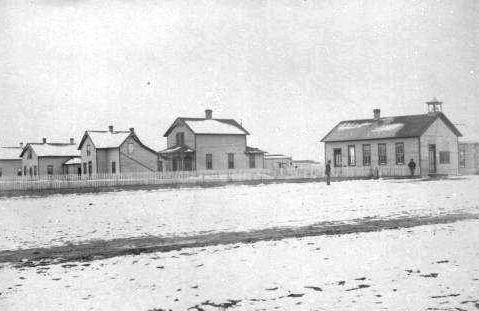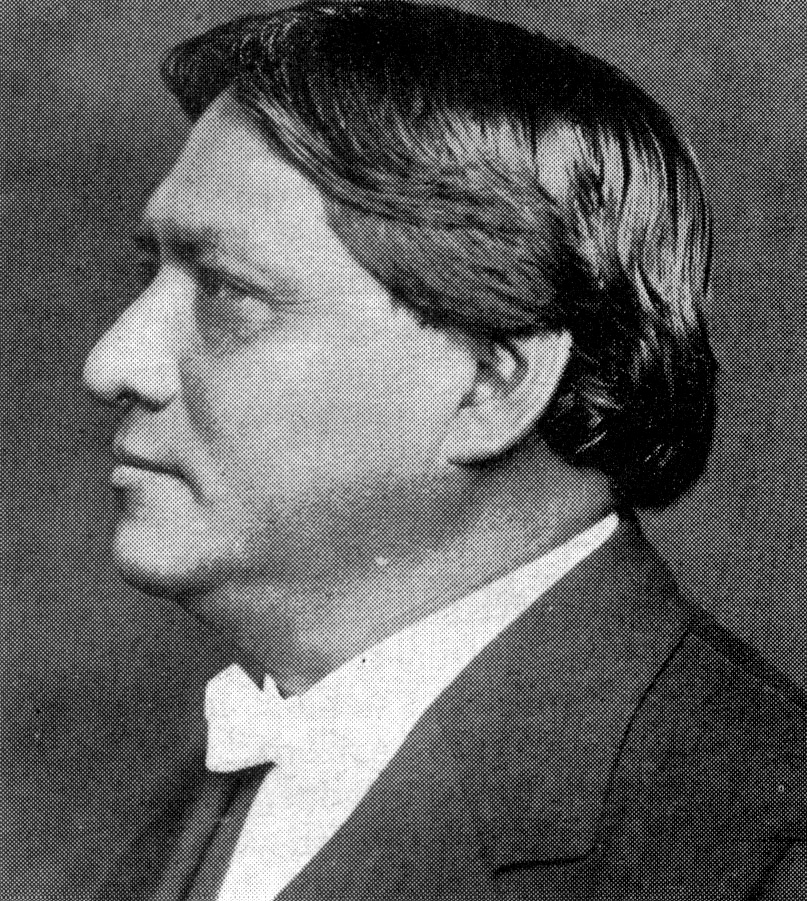Carlos Montezuma's medical practice
Note: In November 2021, Katie Lattal, Head of Special Collections, wrote an article that covered Carlos Montezuma’s entire life particularly his early life and later activism. In this article, we will explore Montezuma’s medical career, which was mostly spent in Chicago.
By Emma Florio, Special Collections Library Assistant
Carlos Montezuma’s professional medical career began while he was still in medical school. Although his tuition was covered because of his unique situation (described in the earlier article), he still needed to pay for room and board. Using what he had learned from a pharmaceutical undergraduate program at the University of Illinois, Montezuma got a job in a pharmacy in Chicago. Because of the demands of this job, it took him an extra year to complete medical school, which he did in 1889.
 |
|
Photograph of Fort Stevenson, within the Fort Berthold Indian Reservation, ca. 1880. Via Digital Horizons.
|
After earning his MD and practicing unsuccessfully in Chicago for a short time, Montezuma felt the desire to be more useful to his fellow Native Americans. Toward that end, he became a physician for the Bureau of Indian Affairs, a federal agency within the Department of the Interior that to this day administers and manages the reservation land on which native people live. Over the next four years he was assigned to three different agencies (administrative regions within the Bureau) on the Western frontier: Fort Stevenson, near Bismarck, North Dakota; the Western Shoshone Agency in western Nevada; and the Colville Agency in northern Washington. He found his work difficult in these places, with poor conditions, lack of funds, few supplies, layers of bureaucracy, and local preference for indigenous medicine men over Western medicine all impeding his efforts to help.
In 1893 he finally ended up at the Carlisle Indian Industrial School in Pennsylvania. Carlisle was the most prominent of the Bureau of Indian Affair’s system of boarding schools which sought to strip Native American children of their own cultures and assimilate them into white society. Montezuma’s position at Carlisle provided him with better opportunities than the frontier placements: it was better equipped and closer to large urban centers that offered more specialized medical care, proximity that also offered learning experiences for Montezuma himself. At Carlisle, he also came into contact with more activists and people involved with policymaking, as well as Carlisle’s founder, Richard Henry Pratt, whose paternalistic philosophy toward the children at the school was to “kill the Indian, save the man.”
|
|
|
Montezuma and nurses at Carlisle, 1893. Via Carlisle Indian School Digital Resource Center.
|
After three years at Carlisle, Montezuma felt he needed to move on and advocate for his people in new ways. Pratt’s influence strengthened his views that the best thing for Native Americans was to assimilate into white culture. As an educated professional he could act as an example of what Native Americans could do if given the right opportunities. To that end, he decided to return to Chicago.
At first, as had been the case after leaving medical school, he did not have much success until a chance encounter provided an excellent opportunity. While walking down State Street one day, he ran into Fenton B. Turck, a gastrointestinal specialist who had graduated from Chicago Medical College two years after Montezuma. After learning of Montezuma’s difficulties establishing a practice, Turck invited him to join his own specialist practice. They would work together for the next 17 years, until Turck moved to New York City, after which Montezuma continued the gastroenterology practice in Chicago. At various times Montezuma had offices in Burnham and Root’s Reliance Building (1 W. Washington) and Holabird and Roche’s Chicago Building (7 W. Madison) in the Loop and home offices in the 3000 and 3100 blocks of what is now South Martin Luther King Jr. Drive, which was near Chicago Medical College and its teaching hospital.
Montezuma also taught at the Chicago Post Graduate Medical School (which was eventually absorbed by the University of Illinois’ medical school) and worked in the school’s Public Dispensary with Turck, where they held an independent clinic three days a week. This helped to supplement his income from treating patients who sometimes could not pay their bills. His correspondence includes many letters from patients asking for extra time to pay him. Former patients would also write to him after moving away, continuing to seek him out for medical advice or to receive more medication. He was particularly known for a special salve he created that combined Vaseline and menthol, similar to the modern Vicks VapoRub.
Throughout his life, Montezuma continued to advocate for his fellow Native Americans. He traveled the country giving lectures about his life and beliefs, co-founded the Society of American Indians (SAI), and published a newsletter called Wassaja: Freedom's Signal for the Indians. One particular event allowed Montezuma to combine his medical practice with this advocacy in a very tangible way.
|
|
|
Montezuma in 1915, from Northwestern University Medical School Magazine 8, no. 1, (Winter 1970).
|
On April 7, 1904, a train carrying a group of Sioux performers from Buffalo Bill’s Wild West Show was hit by another train in Melrose Park just west of Chicago. Three people died and sixteen were hospitalized nearby in Maywood. After learning about this, Montezuma wrote to the Commissioner of Indian Affairs asking to be named the physician in charge of the injured Native Americans. He did this to better advocate for their compensation. The railroad company had its own physicians who estimated the amount that the victims should be paid, often downplaying their injuries to the white railroad executives. Montezuma gave much more detailed descriptions of their injuries and called for $51,000 in damages in contrast to the $17,000 estimated by the railroad. In the end, the Bureau of Indian Affairs sided with the railroad, further disillusioning Montezuma with the organization.
Later in life, Montezuma used his skills and experience as an activist to advocate more specifically for the Yavapai tribe of Arizona, of which he was a member. A trip to Arizona in 1901 had brought him back to places from his childhood for the first time and he became more involved with the tribe. Seeing his people’s connection to their land also helped him reverse his stance on assimilation and to fight for the rights of Native Americans to remain on their ancestral lands and become self-sufficient. Two years later, with his help, the Fort McDowell reservation was established for the Yavapai. He spent the rest of his life fighting for them. In 1922 he contracted tuberculosis and decided to permanently return to Arizona. He died at Fort McDowell on January 31, 1923.
Selected References
Fent, Cynthia. “The Medical Practice of Carlos Montezuma, Yavapais [sic] Physician and Indian Reformer.” Master’s thesis, Fort Hays State University, 1990.
Iverson, Peter. Carlos Montezuma and the Changing World of American Indians. Albuquerque: University of New Mexico Press, 1982.
Speroff, Leon. Carlos Montezuma, M.D.: A Yavapai American Hero. Portland, OR: Arnica Pub., 2003.
Updated: November 14, 2023

